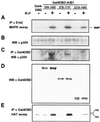AIB1 is a conduit for kinase-mediated growth factor signaling to the estrogen receptor
- PMID: 10866661
- PMCID: PMC85954
- DOI: 10.1128/MCB.20.14.5041-5047.2000
AIB1 is a conduit for kinase-mediated growth factor signaling to the estrogen receptor
Abstract
Growth factor modulation of estrogen receptor (ER) activity plays an important role in both normal estrogen physiology and the pathogenesis of breast cancer. Growth factors are known to stimulate the ligand-independent activity of ER through the activation of mitogen-activated protein kinase (MAPK) and the direct phosphorylation of ER. We found that the transcriptional activity of AIB1, a ligand-dependent ER coactivator and a gene amplified preferentially in ER-positive breast cancers, is enhanced by MAPK phosphorylation. We demonstrate that AIB1 is a phosphoprotein in vivo and can be phosphorylated in vitro by MAPK. Finally, we observed that MAPK activation of AIB1 stimulates the recruitment of p300 and associated histone acetyltransferase activity. These results suggest that the ability of growth factors to modulate estrogen action may be mediated through MAPK activation of the nuclear receptor coactivator AIB1.
Figures






References
-
- Anzick S L, Kononen J, Walker R L, Azorsa D O, Tanner M M, Guan X Y, Sauter G, Kallioniemi O P, Trent J M, Meltzer P S. AIB1, a steroid receptor coactivator amplified in breast and ovarian cancer. Science. 1997;277:965–968. - PubMed
-
- Bautista S, Valles H, Walker R L, Anzick S, Zeillinger R, Meltzer P, Theillet C. In breast cancer, amplification of the steroid receptor coactivator gene AIB1 is correlated with estrogen and progesterone receptor positivity. Clin Cancer Res. 1998;4:2925–2929. - PubMed
-
- Bourguet W, Ruff M, Chambon P, Gronemeyer H, Moras D. Crystal structure of the ligand-binding domain of the human nuclear receptor RXR-alpha. Nature. 1995;375:377–382. - PubMed
-
- Brandt B H, Roetger A, Dittmar T, Nikolai G, Seeling M, Merschjann A, Nofer J R, Dehmer-Moller G, Junker R, Assmann G, Zaenker K S. c-erbB-2/EGFR as dominant heterodimerization partners determine a motogenic phenotype in human breast cancer cells. FASEB J. 1999;13:1939–1949. - PubMed
Publication types
MeSH terms
Substances
Grants and funding
LinkOut - more resources
Full Text Sources
Other Literature Sources
Molecular Biology Databases
Miscellaneous
